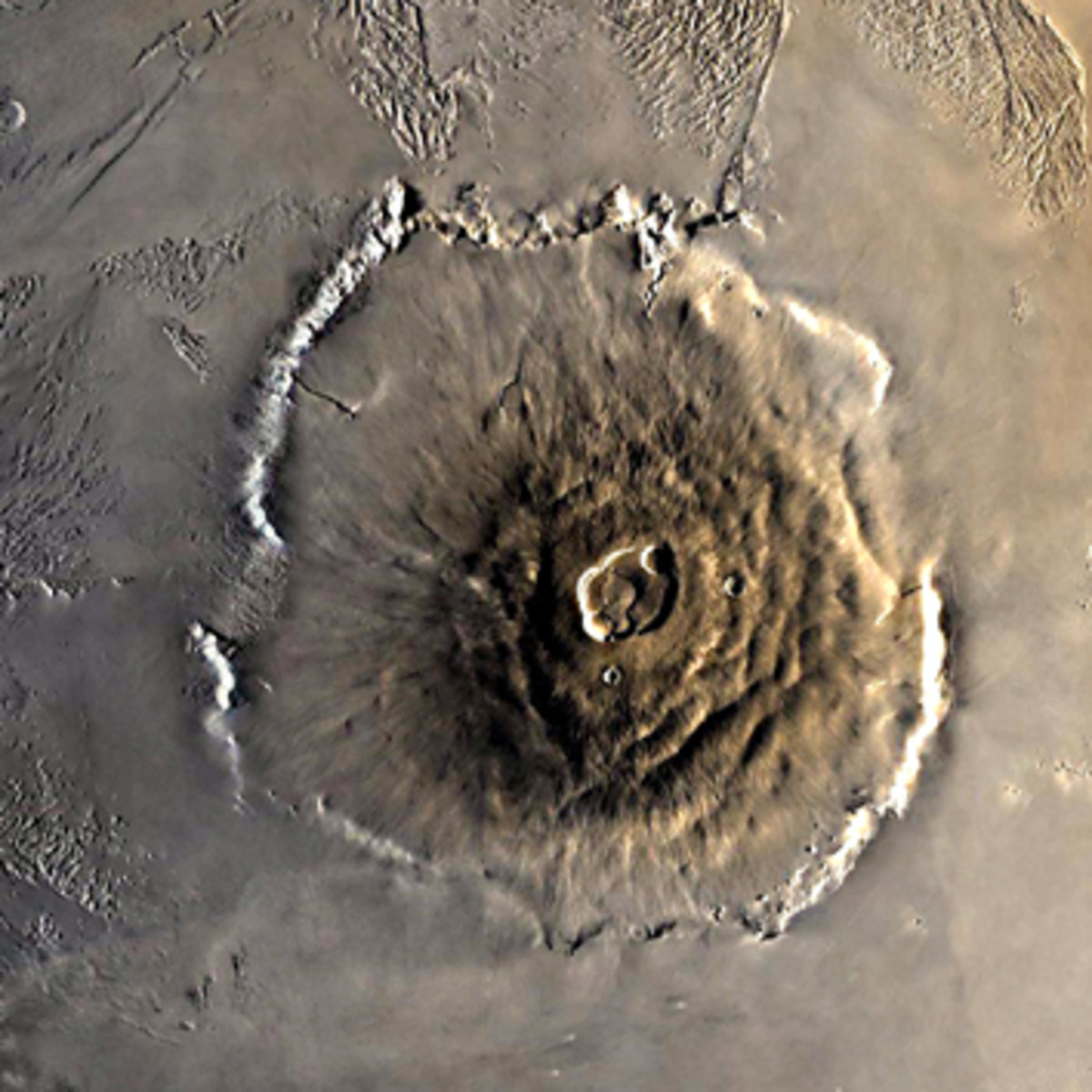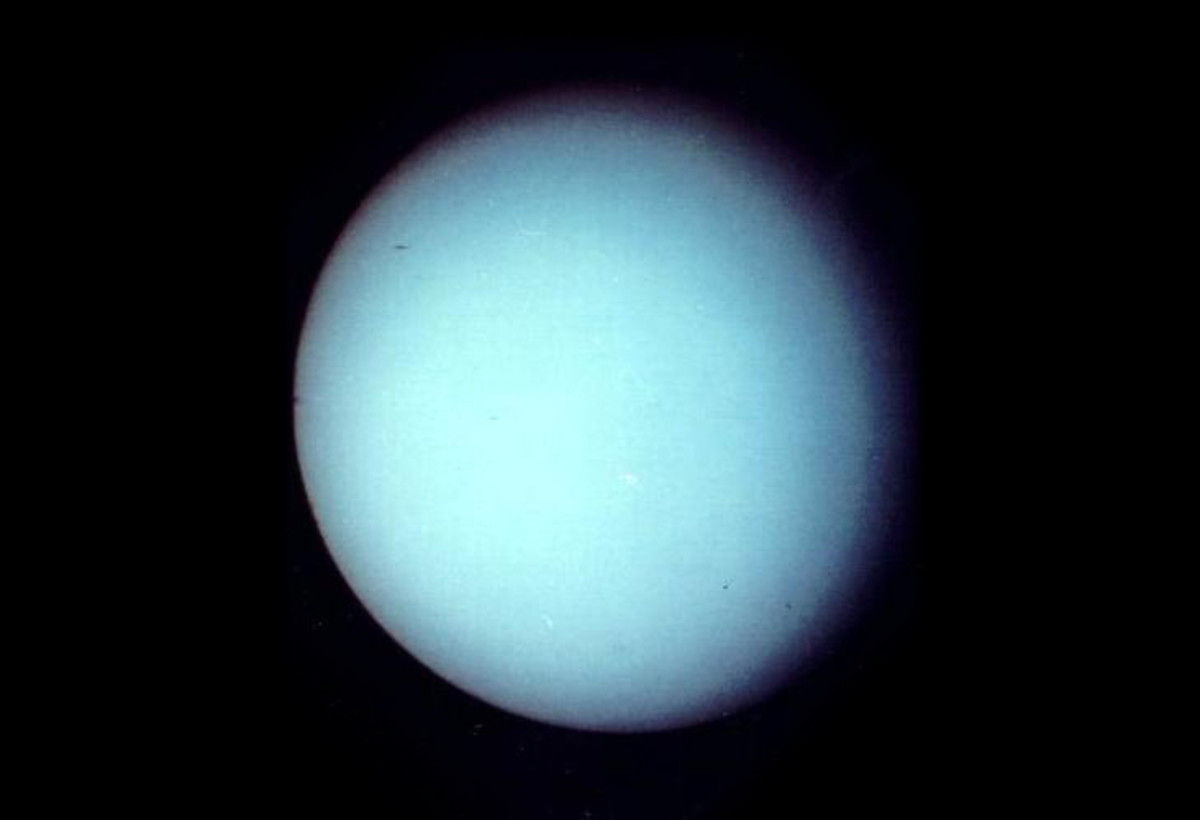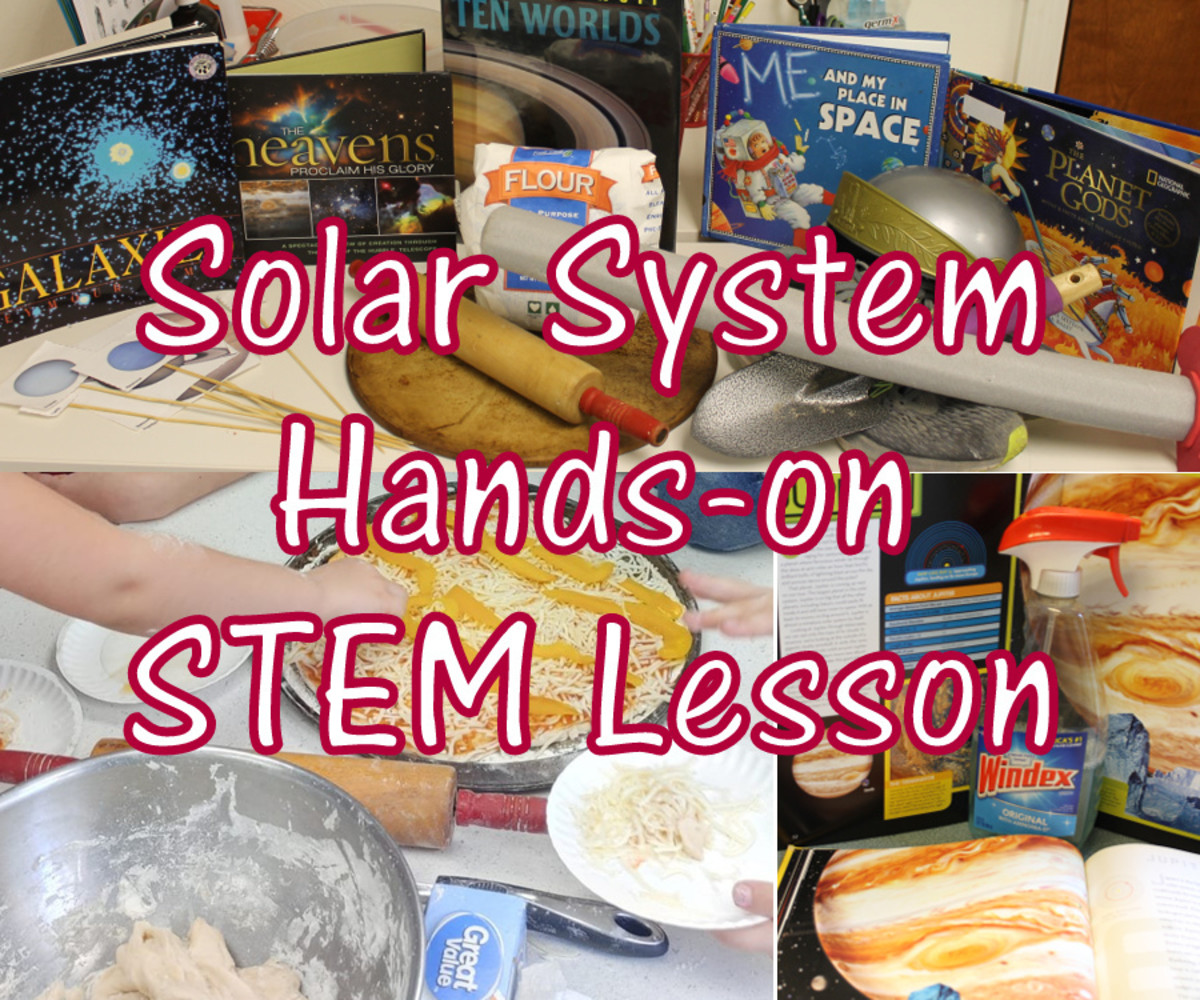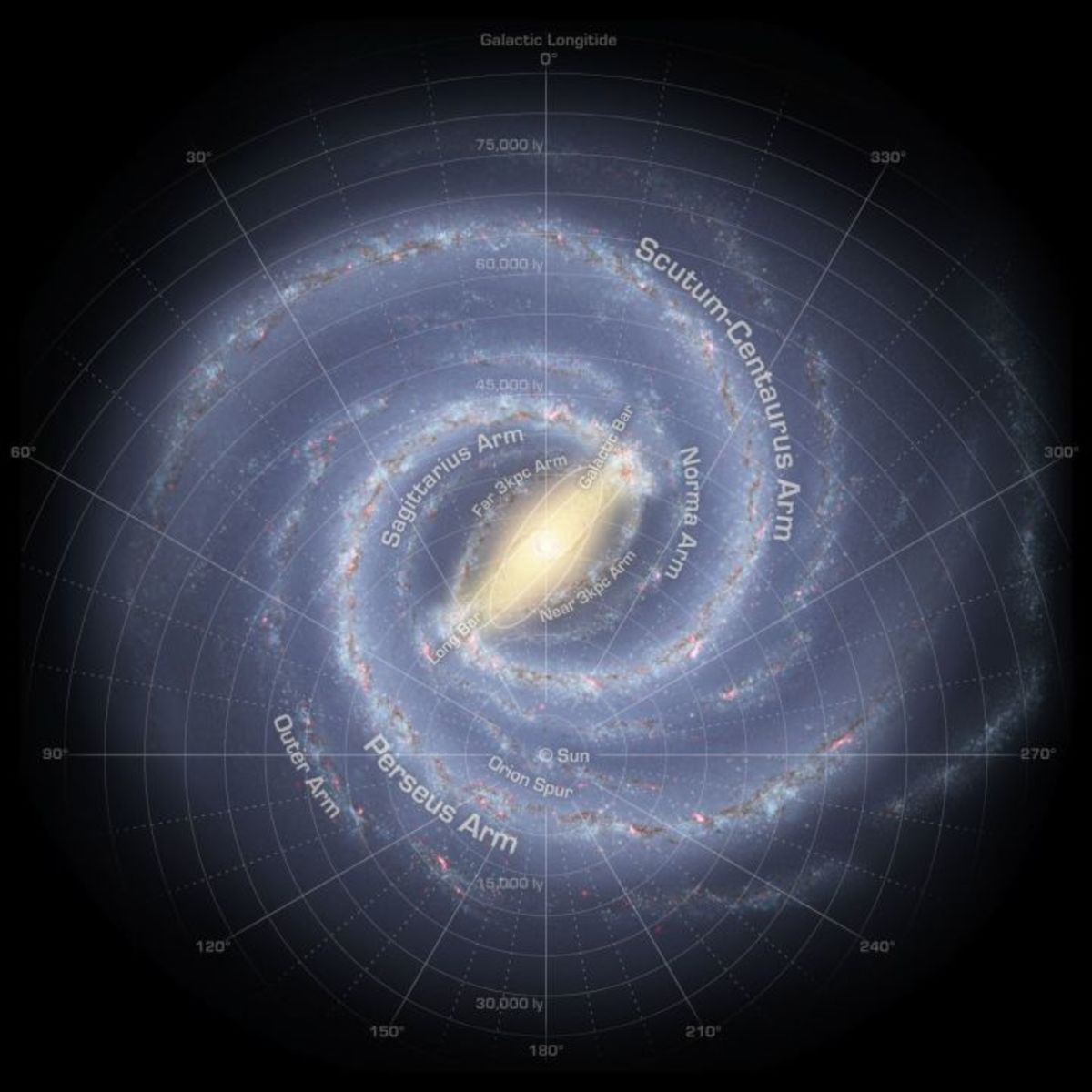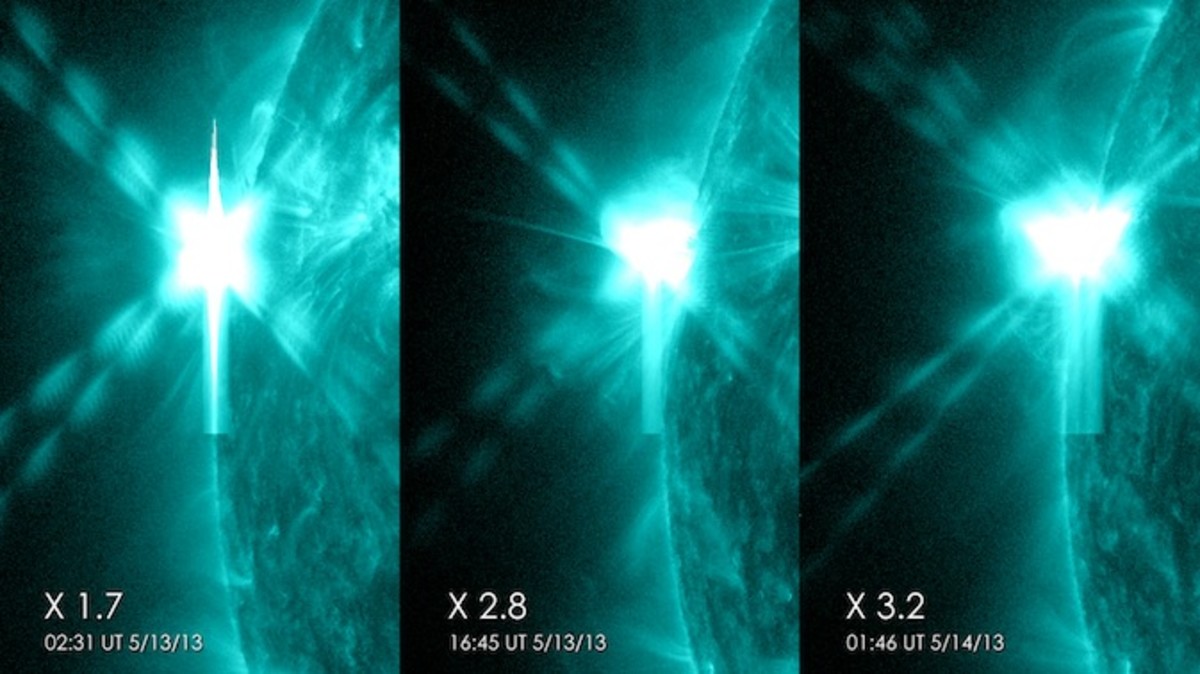The Evolution of the Earth and the Solar System
The birth of the moon occurred early in the solar system evolution
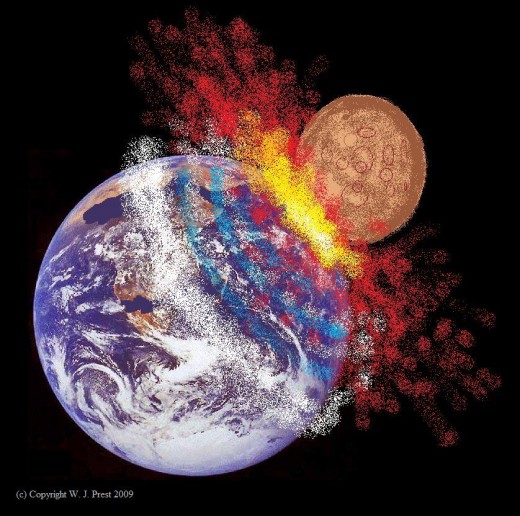
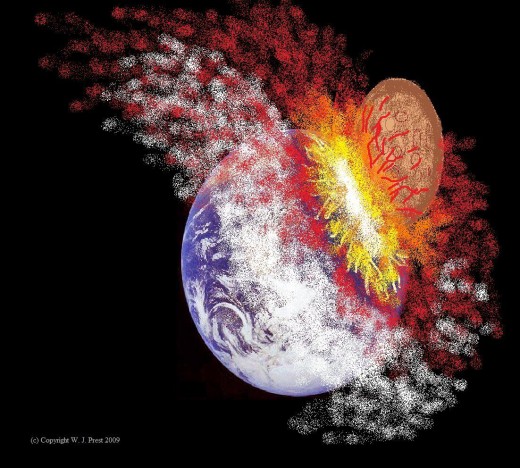
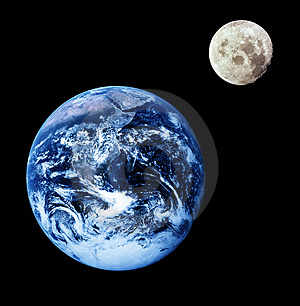
The birth of the moon is just one of the events in the evolution of the solar system
Five discrete stages exist in the evolution of a solar system like ours. Then there are solar systems that evolve differently than the type we are familiar. They have evolutionary events in common, though the processes of formation of the entire systems differ radically. We will call these type 1, type 2 and type 3 solar systems. Type 1, which will be discussed first, simply because we are more familiar with this one, is detailed below. Type 1 is like our solar system that forms from a disk of rotating material. Later, we will explore systems completely unlike the accretion disk type system such as ours. All types of systems have discrete stages that can be found occurring together or sequentially that are both discrete and identifiable. These are,
The nebular condensation, quantum gravitational and stellar formation era. There is also planetary formation due to nova.
The electrostatic accretion and disk formation era.
The light impact accretion era.
The gravitational accretion era.
The stabilization era.
Type 1 stellar systems evolve from formlessness into T-Tauri or FU-Orionis type star. This early stage of a stars life, which commences once fusion starts, is a very unstable and violent. The star is still in collapse and is gravitationally accumulating nearby nebular material. The accretion is fast and violent, often exceeding the ability of the star to absorb the material. Some of it is blown off in bipolar jets that can be sporadic, emitting plasma in spurts. This has been seen in process over the last several years and has been turned into a movie by NASA from observations gathered by the Hubble telescope. The process of evolution is surprisingly fast. But this is just one way a planetary system can evolve. Below is described a method determined by Professor Oliver Manuel whereby planets can be born after a supernova. It is an alternative route of planetary evolution that for the most part, follows the stages of accretion. The beginning differs from the nebular route.
Once the heavy concentration of material is cleared in the vicinity of the rotating star, the angular momentum between the star and the nebula around it becomes concentrated around the star's equatorial plane. The more oblate the central star is due to rapid rotation, the flatter the disk that evolves. A miniature version of this is seen at Saturn. The early accretion disk begins to take shape. The star is still in its early violent phase, oscillating between gravitational compactness and radiative expansion. Intense magnetic fields are set up and charge the young accretion disk differentially. Along charge and magnetic sector boundaries radiating out from the star in a spiral fashion, electrostatic accretion occurs with intensity. Enormous discharges occur within the disk that fuses some of the early fluffy chunks that have formed due to static cling. This continues as the star remains in its early stage of evolution. Early stars also flare frequently with massive coronal ejections and this has a double action of blowing away material and sintering larger pieces. This helps to explain why some stoney chondrules are sintered and others are not. The static cling idea has recent confirmation within an experiment performed on the space shuttle during September 28, 2000 08:08 CDT.
"An experiment aboard a space shuttle has recreated the birth of the Solar System from a cloud of dust and gas. Scientists saw spidery structures form, and say this solves the mystery of how the primordial cloud coalesced into the planets. Astronomers believe that the Earth and other planets formed from stardust and gas orbiting the young Sun. But they have never understood how the dust started to clump together. The gravity of these tiny particles is not nearly strong enough to draw them together. To plug the gap, scientists have speculated that the van der Waals forces between dust particles might be enough to draw them into clumps of 100 or 1000 particles, when gravity might take over. But till now, there was no evidence that this could work. As reported in New Scientist, an international team led by Jurgen Blum at the University of Jena in Germany floated dust clouds in low pressure conditions on board the NASA shuttle Discovery. Under the low gravity conditions in orbit they saw the dust forming into long spidery chains that could easily catch onto each other to form ever-larger clumps. They say this is the first step in a chain, which would result in kilometre-sized bodies called planetesimals. These would have enough mass for gravity to force them together into planets."
The foregoing does not take into account quantum gravitational effects resulting from the interaction of virtual particles with real ones. During this early stage, larger objects in orbit within the nebular accretion disk start to sweep up the material, which consists of billions of small objects orbiting around the star. Collisions occur frequently, breaking some asunder and adding to others until a crucial stage is reached. From this humble beginning, Earth was born in the midst of all the other vying competitors. Earth grew into something completely different than anything else in the observable universe, making it a special place.
At about 100 kilometers, the transition between soft impact accretion and gravitational accretion occurs. The larger bodies begin to not only sweep up material in their orbits, but also to attract bodies out of nearby resonant orbits within the accretion disk. This can also be called the violent and frequent impact era that falls off exponentially over time as innumerable smaller objects are gathered into a few large ones. This is a discrete type of phenomena in its own right. The gravitational era of accretion is what is by and large the dominant feature of our present solar system from Mercury out to Pluto-Charon. Earth and Moon are part of this process. Beyond Pluto-Charon lies the Kuiper belt that seems to be at the juncture of the light impact era and primary stages of the gravitational era. Recent observations have revealed over 400 Trans Neptunian Objects (TNO), some challenging the size of Pluto and Charon. Some, like Sedna are on highly elongated orbits. Other observations entail the slowing of the two Voyager spacecraft, now some 12 and 14 billion miles out from the sun. These observations indicate the craft are slowing faster than can be accounted for the sun's and solar system's gravity alone. Either the craft are being influenced by TNO's or dust in the Kuiper belt, or a combination of both. This is how a few stages can exist simultaneously with one solar system such as ours.
The final stage is typical of a well aged stellar system in which most of the smaller debris is cleaned up and only large planets exist well separated from each other in dissonant orbits around the central star.
Typically, the larger the system is, the faster the evolution. The smaller the system is, the slower is its evolution. Inner regions closer to the star evolve faster than regions further away due to the greater velocities closer to the central star. It also follows that the severity of impacts increases in proportion to gravitational acceleration. All planets get heavily bombarded and this is what happened on Earth some 4 billion years ago. During this time, a Mars sized protoplanet struck Earth, reversed the proto Earth's rotation and threw off enough material to create the moon. The Earth was smaller than it is today. In the early days, the Earth had a ring until the new forming moon swept it up. Thus by a violent birth, the moon was born, not as one body, but numerous small chunks in orbit around the Earth in an accretion ring. Yes, for a brief moment of cosmic time the Earth was a ringed planet, much like Saturn, Jupiter, Uranus and Neptune. The Larger pieces in the ring started to accrete into a larger body. The early moon was on a much more inclined orbit than today. Cosmologists estimate that it took mere months for the moon to start to form, just above the Roche limit of the Earth. Over hundreds of thousands of years, most of the ring material was absorbed by the forming moon, back into the Earth, or ejected into the solar system. Some material remains in a ring even today, but these objects are mostly in the moons orbit and may have had a different origin. In the early days, the tidal interaction between the Earth and Moon was enormous. That interaction allowed for rapid transference of angular momentum to linear momentum, throwing the moon further away. As the moon gained distance, tides reduced, the Earth's rotation slowed and the exchange of momenta lessened.
Further, the Earth was spinning so fast; it had a large oblateness akin to Jupiter and Saturn today. The exaggerated equatorial bulge pulled the ring material and forming moon into a more equatorial path. The oblate Earth also flung the moon out from the Earth fairly rapidly, helping it to sweep up more accretion material. As a result, the Earth's rotation slowed considerably over the eons. Tides on the Early Earth were enormous, competing with great impact generated tsunamis, eroding most but the very largest of early scars.
When did this fateful separation occur due to a monster impact? Today, we know that the moon is moving away from the Earth at a rate of about two inches per year. This rate has not been constant throughout the recession period. But assume for a moment that it was. Today, the semi major axis of the moon's orbit is some 239,000 miles. By adding up all the inches over the eons, we find that contact would have existed 7.57 billion years ago. This, of course, is impossible for a solar system only 4.56 billion years old. But the case is made that at the current rate of recession; the moon and Earth were once one body. More accurately, the moon and Earth today were born due to the collision of the early Earth with another body. That event likely occurred during the violent early accretion era between 3.95 and 3.85 billion years ago.
The real calculation is a good deal more complex than the one stated above. It involves the inverse power function of gravity over distance, complex four dimensional vector calculations involving the oblate early Earth and the accretion ring around the Earth tilted at a high angle to the equatorial bulge. In addition, factors like the angular momentum evolving over the time of the whole system has to be considered. Fortunately for us, this calculation has already been done. The consensus suggests that the giant impact occurred during the heavy bombardment and accretion phase of the early solar system. This suggests that the moon was actually born somewhere between 4.15 to 3.85 billion years ago. After the giant impact, the moon began to form in the early warped accretion disk around the Earth. It had to form outside the Roche limit. The early Earth was spinning rapidly. Sources indicate that a single rotation took a mere six to eight hours. This gave the Earth an oblateness similar to that of the gas giants, Jupiter and Saturn. This enormous equatorial bulge helped to organize the disk and speed the formation of the moon early on. Further, the huge equatorial bulge flung the moon away rapidly at first. As it receded, it gathered up more ring material. In turn, the Earth slowed in rotation and the equatorial bulge shrank, decreasing the Earth's oblateness. The moon's recession from the Earth was rapid in the beginning, slowing as the oblateness of the Earth decreased and the Earth to moon distance increased. Today, the moon recedes as stated above, and the Earth's rotation adds about 0.00001 second per century.
As the Earth and planets form, they organize themselves into stable regions that are dissonant to each other’s orbital periods. Smaller objects can have a long independent life provided that they are outside of the planets gravitational influence and not in orbital resonance. To qualify, three conditions must be met. The body must not orbit between the Lagrange point 1 point and an orbiting planet, nor between Lagrange point 2 and the planet. The body must not be in orbital resonance with any planet. If by chance, it does stray inside the Lagrange points, it will be captured into a retrograde orbit by that planet, to become part of the retinue of its moons. New discoveries of small moons in distant orbits about Jupiter and Saturn have found that all of these objects are in retrograde orbits. This evidence vindicates the ideas of Kuiper and Weiszacker. These bodies also prove that there is an abundance of material orbiting between any consecutive pair of planets. These bodies are captured by the giant planets and wind up in retrograde orbits. At this update, Saturn has some 60 plus bodies in orbit, and Jupiter has 13 new moons, all of which are small and in retrograde orbits.
Since the earth is still largely in the gravitational accretion stage, asteroids, comets and meteoroids cross our planet's orbit from time to time and impact with it. Since there are far many more small objects than large ones, the small ones impact more frequently. The impacts can be readily observed in the 16 annual known meteor showers. Larger objects are more rare, but occasionally, they too will hit the Earth as the solar system continues to evolve. One such event occurred in the Tungeska region of Siberian Russia on June 30th, 1908. The larger ones are the stuff of myth generation, reports that inspire things like comet dread and writers like Immenuel Velikovsky. The Bible contains hints of dreadful events within the observation time of humanity on Earth. Descriptions of mountains falling out of the sky and world girdling floods are contained in it. Research into large impact dynamics coupled with what occurred by way of observing the 22 pieces of Shoemaker Levy-9 crash into Jupiter in July of 1994 demonstrate that such "myths" can be inspired from real observation and are physically possible even now.
During its evolution, the Earth went through many stages before it became suitable for life. From heavy bombardment and the recession of the moon, the Earth's rotation slowed to a three times as long as what it was after the great moon forming impact. There was the arrival of life at about 3.1 billion years ago. Continents changed, separated, crashed together and separated again. Three great freezes engulfed the whole Earth. Complex life arrived about 570 million years ago. During the last 500 million years there were five great extinction events and the current 6th one is well under way due primarily to climate change.
Comet dread has plagued humanity. Comet oriented astrology is currently out of fashion. Truly, comets inspired cosmologies and astrologies of the past. Comets can arrive from any place in the heavens since they originate from the Oort cloud, which surrounds the sun on all sides. The impact speed of comets may vary considerably depending on whether they are moving in the same direction as the planets or in retrograde orbits. Often times they move retrograde to planetary orbits. When they hit, they pack a real wallop. A meteoroid that falls to Earth from the main asteroid belt travels a "piddly" 12 km/sec whereas a large comet can hit at 72 km/sec, just because it could be moving around the sun in the opposite direction to the planets. The impact energy from a comet of the same mass as a comparable asteroid can be as much as 36 times the energy based on the above speeds. This does not lessen the danger that comes from large asteroids. It does say that a retrograde comet of just 1/36th the mass of an asteroid in a prograde orbit can inflict the same magnitude of damage.
Earth inhabits a local asteroid belt and there is plenty of opportunity for impact or exploration and utilization just in our own neighborhood. We do not have to wait for a wandering comet, main belt asteroid, Apollo, Aten or Amor object. Near Earth Objects exist in profusion and can supply both a lot of future hazards or opportunities. Both the solar system and other type 1 solar systems, such as those proplyds seen evolving in the Orion Nebula and the more recently discovered type 2 solar systems have these points in common.
Of all stellar systems that can exist, life is most likely to evolve in Type 1 stellar systems such as ours. Type 2 systems would have too much chaos in the orbital dynamics of all the orbiting bodies. Type 3 systems would not be conducive to life on account of the massive, extremely bright, short lived central star involved. Mass relationships would prohibit planets of large enough size to retain an atmosphere and/or water in the presence of the blasting radiation of the primary star, even at several AU. Massive stars tend to go nova more quickly.
the evolution of solar systems
We now know that planetary systems are turning up to be fairly common. They are also strange (from our point of view) in many ways. Many stars have planets that are so close to them, they take mere days to complete an orbit. Others have orbits that are highly eccentric like those of comets in our solar system. Some exosolar planets orbit around pulsars. How is all of this variety and complexity possible. There are several roads to stellar planetary system evolution, each one differing from the others. They can be variously described as follows.
1. Nebular condensation hypothesis
2. Ejection from parent star or pulled off by passing star hypothesis
3. Penetration by rogue bodies
4. Formation from nova ejecta
5. The globular type system
6. The disk system
7. The Lagrangian system
The nebular condensation hypothesis has been around for a long time, and for the longest time, formed the backbone of planetary evolution theory. The principle idea is that a large cloud of interstellar gas and other raw material contracts under gravity and may be assisted by being blown into a smaller space by a nearby super nova. Eventually, the central region becomes a viable star. Other lumps in the nebula condense into planets. This hypothesis is viable because we can see it in operation in the Orion nebula where star and brown dwarf birth is occurring right before us. Some of the brown dwarfs may be in orbit around a star, or eventually become captured into a stellar orbit. It is likely that the solar system and Earth formed this way in the beginning. For the moment, the Orion nebula stars, proplyds and brown dwarfs all seem to be evolving as separate entities.
There is an idea that two stars passing really close to one another can pull material off the surface of one another. Once past, the material may form a disk and condense into planets. This has never been observed, partly because we need to be watching for a long time to see planets evolve from this scenario. We literally would have to see to stars pass, material being pulled out and wait for the loose material to condense into orbiting bodies. The scenario is unlikely, being a type of one in a million shot. Further, the loosened material is more likely to fall onto the more massive star, or be dissipated into interstellar space. The latter scenario has been observed in closely orbiting binary stars. One of these may be a neutron star or a black hole.
We now know that not all bodies that condense in interstellar space are star class bodies. Some brown dwarfs have been observed in the Orion nebula. In addition, microlensing events in the Large Magellanic Cloud and toward the galactic center have suggested dark bodies between us and the star being microlensed that are not on any orbit save around the galactic core. Size distribution in the galaxy tells us that there are far more small bodies than there are large ones. Therefore, independent planet sized bodies ought to litter the interstellar medium. From time to time, passing a little too closely to a star will capture some of these interstellar bodies. They will wind up in a highly eccentric orbit. That orbit will more likely be highly inclined to the stars natural ecliptic as well as being highly eccentric. The orbit is by chance, more likely to be aligned with the galactic disk.
A theory that began to form in 1972 by Prof. Oliver Manuel suggests that planets can literally be formed from the death throes of a super nova. Super novae come in three basic types. There is the gentle nebular ejection that comes in the dying days of a sun mass or less star. Then there is the Type 1 super nova that occurs when a star of 1 to 3 solar masses explodes. Finally, there is the type 2 super nova that results from stars of more than 3 solar masses. It is not known if planets can be born out of the gentle type of ejection, but we are fairly certain that planets can evolve as a result of types 1 and 2 super novae. When a star consumes all its possible nuclear fuel and reaches the iron56 stage, no more energy can be converted by fusion. Instead, the interior implodes and rapidly springs back to strike the in falling upper layers. This creates an instantaneous flash of incredible power and the radiative pressure blasts the upper regions into space. This sudden collapse and bounce back does not occur in an equal way from all vectors, but collapses most at the poles and least at the equator due to the conservation of angular momentum. The result is a directed explosion from both poles and a more mild ejection around the equator forming a disk. Examples of this exist in the form of a Hubble photo of Eta Carinea, which is performing this very scenario. Eta Carinea is a super massive star whose core is likely to become a black hole. However, it is already producing two lobes and a disk. The polar lobes or jets permanently leave the star, the equatorial disk will separate with some of the material falling back onto the iron or neutron core or into the black hole, while the rest accretes into bodies in orbit around the former star that just went nova earlier. This attractive description answers why there are planets around pulsars, why we can have iron planets in nearly circular orbits and a gradated system with elements neatly separated as if they had been processed by a mass spectrometer. In our own solar system, another argument exists in the form of chondrite meteoroids. These are entirely made up of tiny spheres fused together. Sometimes there is melting between the tiny spheres as if the whole mass was sintered in extreme heat. In any case, whether the chondrules are sintered or not, they are generally fused together solidly. These most common of stony meteoroids beg the question as to how they became sintered if they originated outside of the solar system. Further, the chondrules must have existed as separate entities before coming together through the various stages of accretion. Also, it is agreed that they originate from the main asteroid belt, so for the most part, are in low eccentricity and low inclination orbits. If they ventured in from outside the solar system, they would average out toward the galactic plane instead of the ecliptic as they do in reality. It seems likely that these chondrules were bits and pieces of an earlier phase of the sun when it went super nova. In addition the existence of large consolidated and crystallized solid iron and iron nickel bodies suggest a more local origin than a distant one. To eject such masses over a considerable distance, measuring light years requires great energy and/or a lot of time. Lighter elements and ionized single atoms can be ejected much further in all directions than heavier objects along a single trajectory. Of course, if something is thrown off only a short distance, than the same energy required to move atoms and dust over the distance of light years, can move something more substantial over the much shorter distance of an astronomical unit. Many asteroids and protoplanets were probably given birth from the post nova sun in this way. The strongest argument is that the bulk of the planetary and orbiting material lies in the equatorial disk around the sun that extends out to the fringes of the Kuiper disk where it joins the Oort cloud. During the nova explosion, heavier elements than iron56 were born in the fireball, seeding the disk with all the elements beyond iron including uranium. Therefore, a test of the theory would be found in uranium and other elements nearly as heavy in the asteroids. The fact that pockets of these elements exist on earth, suggest a delivery by an asteroid rich in such elements. Within Gabon Africa is a body of such material that actually melted down some 2 billion years ago. The mass of uranium may have been delivered there by an impacting asteroid that triggered the meltdown. So far no more information is available. A substantial portion of exo solar systems were probably given birth from a super nova. What remains to be done is to seek out less than solar mass stars like red dwarfs with planetary systems. The discovery of such systems would need analysis to deepen our understanding.
As galaxies evolve out of raw material and by gobbling up smaller galaxies, many bodies are given birth in star burst regions of activity. If the general law of size distribution has any application, then vastly more small bodies would be formed than large ones. Much of the galactic matter may be held within rogue bodies that orbit no other center than the galactic core. Occasionally, some of these would approach and be captured by stars. A dark rogue body will in effect become a captured planet or minor planet. They will seldom be close to the equatorial orbital plane of the star and the orbit will at first be highly eccentric. Only with either the introduction of other rogue bodies, or in interaction with existing planets in orbit, will the orbit of the interloper become less eccentric and pulled more toward the orbital plane of the other bodies. There is as much likelihood that the rogue body will be ejected back into deep space, after altering the orbital dynamics of existing planets. There is at least one theory suggesting that such an event occurred in the solar system during its history. The theory even proposes that people were around to observe and record it. Any rogue planet in orbit around a star is likely to have a radically different spectrographic signature as compared to that of the star. The star might be metal poor and the planet complex with the whole spectrum of elements. A find of this nature would be a classic signature of a captured rogue planet.
There are many theories of how the Earth formed in its context, but we are coming to an understanding of just what scenario applied, at least with the evolution of the Earth itself.
Resources on the evolution of stellar systems


